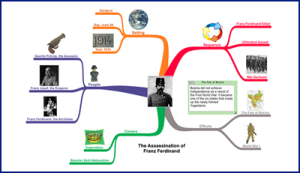 A class website using Inspiration
A class website using Inspiration
This week, I chose to explore the software program Inspiration as a new technology. I chose it because my dad told me he uses it very often, and of course it’s interesting to research technologies that you know are being used.
Inspiration is a computer software program used for creating webs, charts, presentations, and outlines. It encourages visual learning through these tools. It helps students plan, organize and design. I used it on my dad’s work computer (it has to be bought, not just a free download) and found it to be incredibly easy. I am a huge advocate of creating webs before writing essays, and it was a cinch to do so using this program. I randomly chose the main topic of Michigan. With one press of a button, a line extended out to create the sub-topic, and I wrote “Climate.” With two more clicks, I had sub-sub-bubbles reading “Temperate” and “Deciduous forest.” With another click, the program automatically turned my web into a paper outline! How easy!
I also played around and made another web based off of The 3 Little Pigs. The title was at the topic, and lines reading “setting,” “characters,” “plot,” and “conflict” and “resolution” as underlying topics. It was simple to fill out and really easy to navigate.
I thought about how I might incorporate this program in my classroom. Of course, it would be an excellent pre-writing tool. Students could create the topic of their paper and each paragraph, or idea, could be an extension of the web. Students might choose a historical event and organize its details in a web. Another great way to use this would be to transfer the students’ pre-writing or outlines to a Wiki and then having classmates give them feedback! Mostly, it would be used for students to organize their own thoughts, or to learn to organize the thoughts of others.
 An example of event webs on Inspiration
An example of event webs on Inspiration
One tiny drawback to using this program is that some students simply don’t benefit from this type of pre-writing. Some kids are list-makers, in which this program would be unnecessary. Of course, it’d benefit them to at least be introduced to web-making.
Overall, this is a really great and simple way for students to further think of, organize and plan their thoughts. It’s automatically neat (some kids don’t have the best handwriting) and automatically organized. It can be updated as students learn more about a certain topic. It’s a way for students and teachers to stay organized and explore different methods of visual learning.
If you are interested in Inspiration or want to learn more, their website is really informative and has sample activities and webs. Check it out here!









